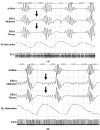Cardiac arrhythmias and sleep-disordered breathing in patients with heart failure
- PMID: 25325536
- PMCID: PMC4227240
- DOI: 10.3390/ijms151018693
Cardiac arrhythmias and sleep-disordered breathing in patients with heart failure
Abstract
The relationship between heart failure (HF), sleep-disordered breathing and cardiac arrhythmias is complex and poorly understood. Whereas the frequency of predominantly obstructive sleep apnea in HF patients is low and similar or moderately higher to that observed in the general population, central sleep apnea (CSA) has been observed in approximately 50% of HF patients, depending on the methods used to detect CSA and patient selection. Despite this high prevalence, it is still unclear whether CSA is merely a marker or an independent risk factor for an adverse prognosis in HF patients and whether CSA is associated with an increased risk for supraventricular as well as ventricular arrhythmias in HF patients. The current review focuses on the relationship between CSA and atrial fibrillation as the most common atrial arrhythmia in HF patients, and on the relationship between CSA and ventricular tachycardia and ventricular fibrillation as the most frequent cause of sudden cardiac death in HF patients.
Figures



Similar articles
-
Nocturnal Cardiac Arrhythmias in Heart Failure With Obstructive and Central Sleep Apnea.Chest. 2024 Dec;166(6):1546-1556. doi: 10.1016/j.chest.2024.08.003. Epub 2024 Aug 20. Chest. 2024. PMID: 39168180 Clinical Trial.
-
Sleep-disordered breathing in heart failure.Eur J Heart Fail. 2016 Apr;18(4):353-61. doi: 10.1002/ejhf.492. Epub 2016 Feb 11. Eur J Heart Fail. 2016. PMID: 26869027 Review.
-
Rationale and design of the SERVE-HF study: treatment of sleep-disordered breathing with predominant central sleep apnoea with adaptive servo-ventilation in patients with chronic heart failure.Eur J Heart Fail. 2013 Aug;15(8):937-43. doi: 10.1093/eurjhf/hft051. Epub 2013 Mar 27. Eur J Heart Fail. 2013. PMID: 23535165 Free PMC article. Clinical Trial.
-
Sleepiness and activity in heart failure patients with reduced ejection fraction and central sleep-disordered breathing.Sleep Med. 2017 Jun;34:217-223. doi: 10.1016/j.sleep.2016.11.022. Epub 2017 Jan 23. Sleep Med. 2017. PMID: 28431823
-
Sleep-Disordered Breathing and Arrhythmia in Heart Failure Patients.Sleep Med Clin. 2017 Jun;12(2):229-241. doi: 10.1016/j.jsmc.2017.01.003. Epub 2017 Mar 9. Sleep Med Clin. 2017. PMID: 28477777 Review.
Cited by
-
Brainstem C1 neurons mediate heart failure decompensation and mortality during acute salt loading.Cardiovasc Res. 2025 Apr 22;121(2):241-253. doi: 10.1093/cvr/cvae261. Cardiovasc Res. 2025. PMID: 39775485 Free PMC article.
-
Correlation Analysis between Obstructive Sleep Apnea Syndrome (OSAS) and Heart Rate Variability.Iran J Public Health. 2017 Nov;46(11):1502-1511. Iran J Public Health. 2017. PMID: 29167768 Free PMC article.
-
A new mechanism links preamyloid oligomer formation in the myocyte stress response associated with atrial fibrillation.J Mol Cell Cardiol. 2015 Mar;80:110-3. doi: 10.1016/j.yjmcc.2014.12.005. Epub 2014 Dec 23. J Mol Cell Cardiol. 2015. PMID: 25541246 Free PMC article. No abstract available.
-
Poor Sleep Quality Associated With High Risk Of Ventricular Tachycardia After Acute Myocardial Infarction.Nat Sci Sleep. 2019 Oct 31;11:281-289. doi: 10.2147/NSS.S222359. eCollection 2019. Nat Sci Sleep. 2019. PMID: 31802960 Free PMC article.
-
Pathophysiological Mechanisms to Review Association of Atrial Fibrillation in Heart Failure With Obstructive Sleep Apnea.Cureus. 2021 Jul 1;13(7):e16086. doi: 10.7759/cureus.16086. eCollection 2021 Jul. Cureus. 2021. PMID: 34345562 Free PMC article. Review.
References
-
- Sin D.D., Fitzgerald F., Parker J.D., Newton G., Floras J.S., Bradley T.D. Risk factors for central and obstructive sleep apnea in 450 men and women with congestive heart failure. Am. J. Respir. Crit. Care Med. 1999;160:1101–1106. - PubMed
-
- Rao A., Georgiadou P., Francis D.P., Johnson A., Kremastinos D.T., Simonds A.K., Coats A.J. Sleep-disordered breathing in a general heart failure population: Relationships to neurohumoral activation and subjective symptoms. J. Sleep Res. 2006;15:81–88. - PubMed
-
- Shigemitsu M., Nishio K., Kusuyama T., Itoh S., Konno N., Katagiri T. Nocturnal oxygen therapy prevents progress of congestive heart failure with central sleep apnea. Int. J. Cardiol. 2007;115:354–360. - PubMed
Publication types
MeSH terms
LinkOut - more resources
Full Text Sources
Other Literature Sources
Medical
Research Materials
Miscellaneous

